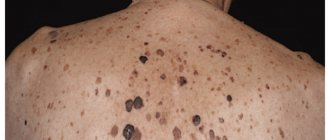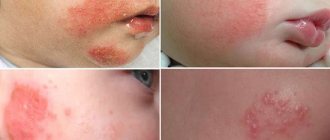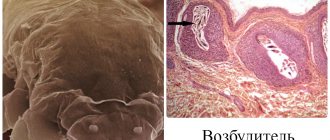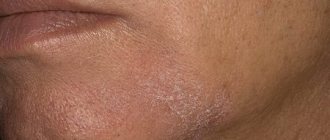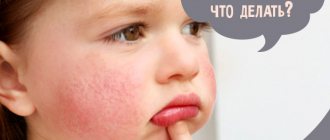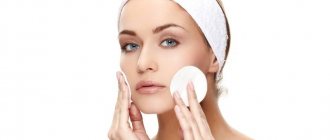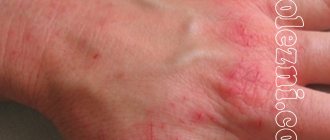Causes of disease development on the skin of the face
Oily seborrhea on the skin of the face can be caused by a number of specific reasons.
- Disturbance of hormonal metabolism, especially in women, which is caused by gynecological diseases, as well as genetic predisposition.
- Long-term uncontrolled use of steroid medications.
- Improper diet with large amounts of fatty, spicy and sweet foods.
- Increased emotional stress, constant stressful situations.
- Mental illnesses such as manic depression and epilepsy.
- Pathologies in the gastrointestinal tract, intestinal dysbiosis.
- Alcohol abuse and smoking.
Diagnostics
First of all, the doctor collects an anamnesis. Then the risk factor for developing the disease, nervous disorders, genetic predisposition, living and working conditions are determined.
Laboratory tests are prescribed:
- Blood chemistry, which allows you to determine the functioning of internal organs, liver, pancreas, biliary tract, and obtain an informative assessment of the metabolism of proteins, lipids, and carbohydrates. Cost of analysis: from 2 thousand rubles.
- Hormonal blood test to evaluate the functioning of the thyroid gland. The cost of the study is from 3 thousand rubles.
- Trichogram , with its help the condition of hair and skin is assessed. The cost of the procedure is from 3 thousand rubles.
- Ultrasound of the thyroid gland , gastrointestinal tract (if necessary). Cost from 2 thousand rubles.
Differences between oily seborrhea and dry seborrhea
Unlike oily seborrhea, the dry form is accompanied by:
- decreased secretion of sebaceous glands;
- flaky skin and itching, whereas with the oily type it will be shiny.
- keratinized skin flakes collect in the corners of the mouth, nasolabial folds, and also the bridge of the nose;
- the scales are dirty gray in color;
- when irritated, massive yellow crusts form.
Folk remedies
Unofficial medicine recipes offer different ways to combat seborrheic dermatitis:
- Oak bark decoction. Boil a mixture of ground bark and water, taken in a ratio of 1:5, for about half an hour. Stir 1 tsp in the prepared broth. honey Wipe the damaged areas, rinsing off any remaining product after 2-3 hours.
- Honey and water. Combine the components in a ratio of 1 to 9. Wipe the affected areas of the skin with the prepared solution, lightly massaging it. Wash off any remaining product only after a few hours.
- An infusion based on a collection of herbs. In equal parts, take calendula flowers, chamomile and plantain leaves (1 tbsp per glass of boiling water). Pour into a thermos and leave overnight. Treat areas of the face affected by dermatitis in the morning and evening after washing.
Forms and characteristic symptoms
Oily seborrhea, depending on the quantity and quality of the sebaceous gland derivative, is usually divided into two forms: thick and liquid.
Both forms are manifested by excessive work of the sebaceous glands and increased production of their secretions.
Thick
Thick is accompanied by increased formation of pasty secretion of the sebaceous glands, which is characterized by the following symptoms on the skin:
- The presence of comedones not only on the face, but also on the skin of the chest and back.
- The skin has a dirty brown-gray color.
- Purulent rashes in the form of blackheads, acne and boils constantly appear.
- Possibly suppuration and abscess formation.
Important!
In severe cases with the formation of boils and abscesses, surgical intervention may be required.
Liquid
With this type, the skin glands produce a liquid secretion. The following formations may appear on the skin:
- Sebaceous cysts appear as small yellow nodules called milia or whiteheads.
- Seborrheic eczema is accompanied by peeling, itching and redness.
- Areas of baldness in the eyebrows, as well as beards and mustaches in men.
Important!
Regardless of the form of the disease, facial seborrhea requires mandatory treatment and observation by a specialist.
Symptoms
Symptoms and manifestations of seborrheic dermatitis can be confused with the following diseases:
- psoriasis;
- contact dermatitis;
- atopic dermatitis;
- lichen;
- rosacea on the face.
Seborrheic dermatitis on the face symptoms and treatment
Symptoms of seborrheic dermatitis are:
- redness of the skin, increased sensitivity to soap, cosmetics;
- itching;
- peeling;
- coarsening of the affected areas;
- the appearance of white and then yellow scales and papules on the face.
Note! It is difficult to make a diagnosis on your own without laboratory testing. At the first signs of skin irritation, you should consult a doctor.
The development of the disease occurs stepwise, increasing. Symptoms get worse over time. The areas affected by the fungus increase, the inflammatory process is added, and a complication arises in the form of acne on the face.
Redness of the skin on the face is accompanied by itching and swelling. In places where the skin naturally folds (behind the ears, near the nose, nasolabial folds), creases and cracks form, which can burst and bleed.
Exfoliated skin accumulates and becomes saturated with sebum, acquiring a yellow color and the appearance of solid crusts. If seborrheic dermatitis is not treated adequately, inflammatory processes will develop.
Inflammation is expressed in the appearance of a polymorphic rash. In the center of the scales, papules are formed - bubbles with liquid contents.
At the last stage of development of seborrheic dermatitis on the face, complete blockage of the sebaceous and fatty ducts and inflammation of the hair follicles are added. This is expressed in the appearance of persistent acne.
Seborrheic dermatitis on the face photos and types
The above symptoms and manifestations of seborrheic dermatitis on the face cause moral suffering to patients and greatly worsen the patient’s quality of life. However, with adequate and timely treatment, stable remission of the disease can be achieved. Maintenance therapy will prevent exacerbations from occurring.
How to diagnose the disease?
To make a diagnosis, you should make an appointment with a dermatologist. Based on an external examination, as well as special examination methods, a specialist will determine the form and severity of the disease and prescribe comprehensive treatment.
Additional diagnostic methods include:
- Biochemical analysis, as well as determination of hormone levels in the blood.
- Ultrasound examination to detect diseases of the ovaries, thyroid gland and adrenal glands.
- Consultation with related specialists such as a gastroenterologist, endocrinologist, gynecologist and trichologist.
Important!
It is imperative to carry out a differential diagnosis with psoriasis to exclude it.
- Possible complications in the absence of therapeutic therapy
- Possible complications in the absence of therapeutic therapy.
In the absence of proper treatment and in advanced forms, severe complications may occur . These include:
- Spread of the disease to the skin of the chest, back, armpits.
- Attachment of a secondary infection and development of inflammation.
- The formation of boils, carbuncles, and purulent abscesses requiring surgical treatment in a hospital.
Important!
The appearance of purulent foci in the area of the nasolabial triangle is especially dangerous, since any damage to the blood vessels in this area leads to infection in the meninges.
Treatment of dermatitis in children
Severe rashes, irritation, inflammation and blisters are removed with topical medications:
- Glucocorticosteroid group. Medicines of this type are used only under medical supervision. The drugs “Hydrocortisone” and “Prednisolone” have a weak effect, while “Beloderm” and “Flucinar” have a stronger effect. A powerful ointment of a new generation – “Dermovate”.
- At an early age, corticosteroid ointments are also used.
The Ministry of Health identifies and recommends two drugs from the general list that can combat dermatitis and provide comprehensive treatment - Elokom and Afloderm:
- Afloderm is suitable for children from 3 to 6 months and can be used on the face, neck, cheeks and other delicate areas. The active ingredient is alklometasone dipropionate.
- Elokom is available in the form of lotion, cream and ointment. The active ingredient is mometasone furoate. The product is recommended for children from 2 years old; it copes with different forms and stages of dermatitis, even the most complex.
Ointments and creams with hormones are not used if a bacterial infection is suspected, since they not only reduce inflammation, but also weaken local immunity. This leads to the growth of microflora and makes the process more difficult.
Victoria Druzhikina
Neurologist, Therapist
Fighting methods
When a diagnosis of oily seborrheic dermatitis is made, comprehensive treatment is necessarily prescribed , aimed at eliminating etiological factors, as well as external manifestations.
Therapeutic
Therapeutic methods include taking certain drugs that affect the body from the inside.
- The use of physiotherapy such as darsonval, ozone, magnet, laser and cryotherapy.
- Strengthening the immune system with special vitamin and mineral complexes that improve skin condition.
- Elimination of intestinal dysbiosis and restoration of beneficial microflora with the help of sorbents, as well as pre- and probiotics.
- The use of sedatives for seborrhea of neurogenic origin.
- Restoration of hormonal levels and treatment of related diseases.
- It is possible to use ultraviolet radiation in low doses to prevent itching in the affected areas.
Important!
Any medications are taken only as prescribed by a doctor and in a certain dosage. Self-medication can lead to worsening of the disease.
Medication methods
To eliminate external manifestations, special medicinal ointments and creams are used , which reduce the production of sebaceous gland secretions, eliminate inflammation and have an antiseptic effect.
- In the form of ointments, salicylic, zinc, as well as the drugs Radevit, Belosalik, Apilak Grindeks are prescribed.
- The most commonly used products in the form of cream: Skinoren, Zinocap, Panthenol, Losterin and Skin-Cap.
General medications are also prescribed:
- Antihistamines to reduce itching and symptoms of inflammation, Claritin, Tavegil and others.
- Antifungal medicines such as Diflucan and Flucostat.
- Probiotics and prebiotics to normalize intestinal function.
- Antibiotics if a secondary infection develops.
The cream has a light texture and is absorbed faster. However, the ointment has a longer action.
Important!
Long-term use of external hormonal products can be addictive.
Diet
In addition to therapeutic treatment, it is necessary to strictly adhere to a certain diet, since foods and the condition of the intestines directly affect the quality of the sebaceous glands.
A balanced diet will improve the course of the disease and speed up recovery. In nutrition you need to adhere to several principles:
- Frequently eating small meals.
- Exclusion of fatty, hot, spicy and fried foods.
- Reducing the amount of fast carbohydrates, baking, and completely avoiding chocolate.
- The obligatory presence in the menu is bran, which cleanses the intestines of waste and toxins and stimulates its functioning.
- The presence of fresh vegetables and fruits in the daily diet as a source of fiber.
- All dishes must be prepared by boiling, baking or steaming.
- Particular emphasis should be placed on soups, cereals and fermented milk products.
Important!
Once a week, it is recommended to have fasting days on vegetables and fruits, or on kefir, but in no case on water.
Traditional methods
In addition to the main treatment, you can use traditional methods, using various decoctions and lotions based on medicinal plants.
Calendula decoction
To prepare a decoction of calendula, you will need one handful of flowers, which you need to add 200 ml of water and cook in a saucepan for 5-7 minutes. Next, cool and use for daily wiping of the face several times a day.
This solution has an anti-inflammatory and antiseptic effect, and also helps relieve itching.
Lemon Protein Lotion
You can make a lotion based on lemon and chicken protein.
Freshly squeezed juice of one lemon is mixed with one teaspoon of glycerin. Add 100 ml of medical alcohol and the white of one chicken egg. Mix everything thoroughly and treat damaged skin areas with the resulting solution daily.
This product reduces sebum production , dries out the skin, and also reduces the risk of infection.
Dandelion decoction
Dandelion decoction is taken orally 3 times a day before meals. It stimulates metabolism, and also helps to cleanse the body of toxins and strengthen the immune system, which has a beneficial effect on the condition of the skin.
You need to take 2 tablespoons of dried and crushed flowers, leaves and roots of this plant, pour 300 ml of hot water and cook over low heat for 10–15 minutes. Allow to cool and strain, after which you can consume.
Aloe lotion
Aloe is often used as a skin care product. Its action reduces the activity of the sebaceous glands and relieves signs of inflammation.
The lotion is prepared from 3-4 leaves of the plant, which need to be peeled and finely chopped. The resulting slurry is poured with 1 cup of boiling water and cooked for about 15 minutes over low heat.
Wipe your face with this solution 3-4 times a day.
Nettle and vinegar lotion
Due to the content of phytoncides, nettle has disinfectant properties. In addition, decoctions and lotions based on it are used to reduce sebum production.
To prepare the lotion, water is mixed with table vinegar in a 1:1 ratio. In these proportions, take 200 ml of water and vinegar and pour the resulting mixture into 20 g of dried leaves. Then heat for 12–15 minutes.
During the day, the resulting solution is lubricated on the affected areas of the face.
Important!
Folk remedies do not replace the main treatment, but are used only as additional methods to improve the condition of the skin.
Ozone therapy
The most effective physiotherapeutic method for this disease is ozone therapy. During this procedure, active oxygen is formed , which has a beneficial effect on the skin.
- Microcirculation of blood and lymph improves.
- The formation of new cells is stimulated, which promotes rapid regeneration.
- Bactericidal and anti-inflammatory effects on affected areas.
- The production of sebaceous gland secretions decreases and pores become smaller.
Specialized hygiene products
Increasing the level of hygiene improves the condition of the skin. All daily hygiene products must meet certain requirements:
- Do not irritate skin.
- Does not contain alcohol.
- Don't clog pores.
- The label should indicate that this product reduces the amount of acne.
Most often, such products contain zinc and salicylic acid, which reduce skin oiliness and also have a drying and anti-inflammatory effect.
Important!
You need to wash your face 2 times a day, every morning and evening.
Why is dermatitis dangerous?
If the disease is left untreated, the scratched epidermis becomes very sensitive to infections that penetrate through microcracks. The skin on the affected areas becomes rough, the wounds heal with scars.
Allergic dermatitis can accompany other manifestations of allergies - asthma, hay fever, etc.
Skin depigmentation is visible due to the fact that wound healing occurs with the participation of connective tissue.
Psychological discomfort is felt, self-doubt, isolation, and an inferiority complex develop.
Effective prevention
Simple preventive measures will help reduce the risk of oily seborrhea on the skin of the face.
- Daily skin care using properly selected hygiene products.
- A nutritious diet excluding unhealthy foods.
- Quitting bad habits associated with alcohol and cigarettes.
- Annual medical examinations for early detection of common pathologies.
- Reducing the stress load on the body, active physical activity.
Oily seborrhea of the facial skin is an unpleasant disease, which is accompanied by increased activity of the sebaceous glands and a violation of aesthetics.
Thanks to early diagnosis and proper treatment, the outcome of this disease is favorable. Compliance with preventive measures will help avoid the development of this pathology.
Dermatitis on the forehead: as an indicator of the functioning of human internal organs
Subcutaneous pimples and ulcers filled with liquid are localized mainly in the forehead area. What is the reason for the numerous appearance of blackheads (acne) and pimples in this area?
The fact is that most of the glands that produce sebaceous secretions are located in the frontal part of the head. During the active production of this enzyme by the body, the ducts become clogged. Fats accumulate in the subcutaneous layer, thereby forming a favorable environment for the proliferation of various pathogenic microorganisms. These numerous colonies of bacteria contribute to the development of various inflammatory processes in the inner layer of the epidermis. Numerous sebaceous ducts become suppurated. The forehead is covered with various types of rashes.


